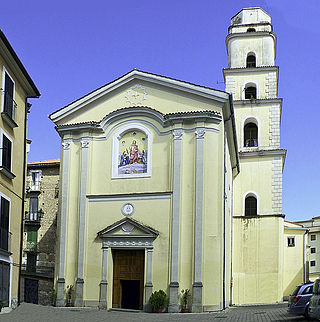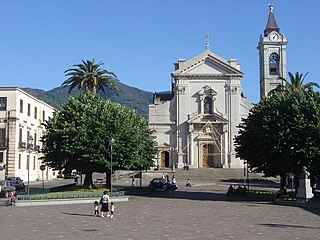
Strongoli is a comune and town with a population of over 6000 people in the province of Crotone, in Calabria, southernmost Italy.

The Diocese of Vallo della Lucania is a Latin Church diocese of the Catholic Church in Campania, has existed under this name since 1945. It is a suffragan of the Archdiocese of Salerno-Campagna-Acerno.

The Diocese of Oppido Mamertina-Palmi is a Latin diocese of the Catholic Church in southern Italy, existing under that name since 1979. Historically it was the Diocese of Oppido Marmertina (Oppidensis). It is a suffragan see of the Archdiocese of Reggio Calabria.

The Diocese of Tivoli is a Latin Church ecclesiastical territory or diocese of the Catholic Church in Latium, Italy, which has existed since the 2nd century. In 2002 territory was added to it from the Territorial Abbey of Subiaco. The diocese is immediately exempt to the Holy See.
The Italian Catholic diocese of Bertinoro existed from 1360 to 1986. In that year it was merged with the diocese of Forlì to create the diocese of Forlì-Bertinoro.

The Italian Catholic diocese of Cariati, in Calabria, existed until 1979. In that year it was united into the archdiocese of Rossano-Cariati. The diocese was a suffragan of the archdiocese of Santa Severina, and then of the archdiocese of Reggio Calabria. In 2001, it became a suffragan of the Archdiocese of Cosenza-Bisignano.
The Italian Catholic diocese of Bitonto, in Apulia, had a short independent existence from 1982 to 1986. In the latter year it was united into the Archdiocese of Bari, forming the Archdiocese of Bari-Bitonto. Before 1982, it had existed since the 9th century until being united into the diocese of Ruvo e Bitonto in 1818.
The Roman Catholic Diocese of Brugnato was a Roman Catholic diocese located in the city of Brugnato in the Province of La Spezia in the Italian region Liguria of Italy. On 25 November 1820, it was united with and suppressed to the Diocese of Luni e Sarzana to form the Diocese of Luni, Sarzana e Brugnato.
Girolamo Zacconi was a Roman Catholic prelate who served as Bishop of Strongoli (1541–1558).
Matteo Zacconi was a Roman Catholic prelate who served as Bishop of Strongoli (1558–1565).
Giovanni Luigi Marescotti was a Roman Catholic prelate who served as Bishop of Strongoli (1585–1587).
The Diocese of Vulturara e Montecorvino was a Roman Catholic diocese located in the city of Volturara Appula in the province of Foggia in the Apulia region of southeast Italy. The bishopric, which already existed in the 10th century, was united with that of Diocese of Montecorvino in 1433. Giuseppe Cappelletti gives detailed information about most of its bishops. In 1818, as part of a reorganization of the dioceses within the Kingdom of the Two Sicilies, the diocese ceased to exist as a residential see and its territory became part of the diocese of Lucera. It is now included in the Catholic Church's list of titular sees.
Tommaso Orsini was a Roman Catholic prelate who served as Bishop of Foligno (1568–1576) and Bishop of Strongoli (1566–1568).
The Roman Catholic Diocese of Lettere-Gragnano was a Latin Catholic diocese located in the commune of Lettere in the Metropolitan City of Naples in the southern-central Italian region Campania. In 1818, it was merged into the Diocese of Castellammare di Stabia.
The Diocese of Umbriatico was a Roman Catholic diocese located in the town of Umbriatico in the province of Crotone in southern Italian region of Calabria. In 1818, it was suppressed with the bull De utiliori of Pope Pius VII, and incorporated in the diocese of Cariati.

The Diocese of Pienza was a Roman Catholic diocese located in the town of Pienza in the province of Siena, in the Val d'Orcia in Tuscany between the towns of Montepulciano and Montalcino. Until 1462, the town was known as Corsignano. It took the name Pienza from its most famous native son, Pope Pius II, who elevated the town to the status of a city (civitas), and established the new diocese. The diocese existed as an independent entity from 1462 to 1772, directly subject to the Holy See (Papacy).
Tommaso Caracciolo (1478–1546) was a Roman Catholic prelate who served as Archbishop of Capua (1536–1546), Bishop of Trivento (1502–1540), Apostolic Nuncio to Naples (1534–1535), and Bishop of Capaccio (1523–1531).
The Diocese of Fondi or Diocese of Fundi was a Roman Catholic diocese located in the town of Fondi in the province of Latina, Lazio, central Italy. In 1818, it was suppressed to the Diocese of Gaeta. It was restored as a Titular Episcopal See in 1968.
Nicola Ippoliti was a Roman Catholic prelate who served as Archbishop of Ariano (1498–1511), Archbishop of Città di Castello (1493–1498), Archbishop of Rossano (1481–1493), and Bishop of Ariano (1480–1481).
Tommaso Stella, O.P. also Domenico Stella was a Roman Catholic prelate who served as Bishop of Capodistria (1549–1566), Bishop of Lavello (1547–1549), and Bishop of Salpi (1544–1547).





